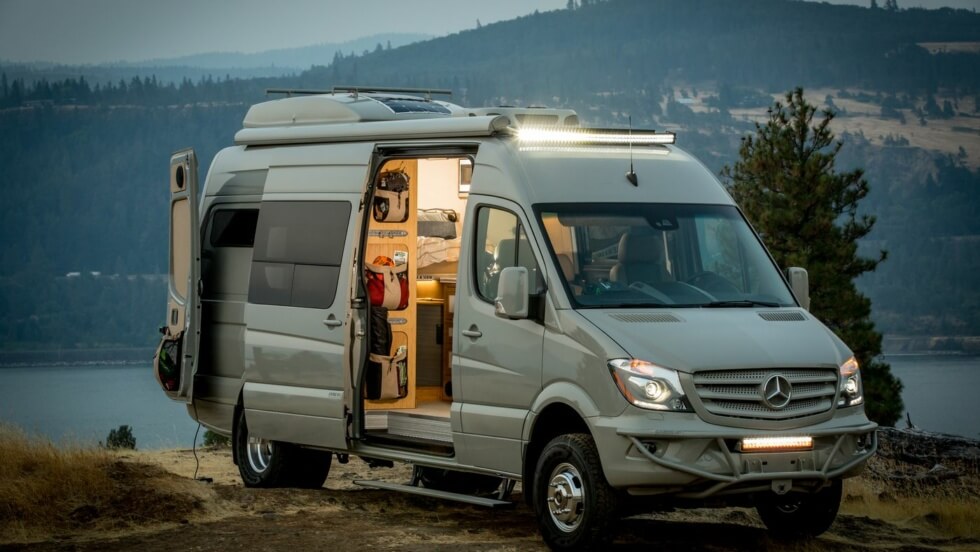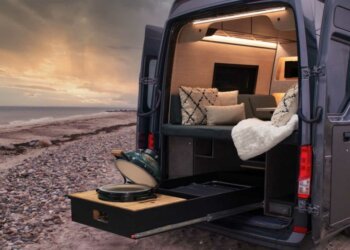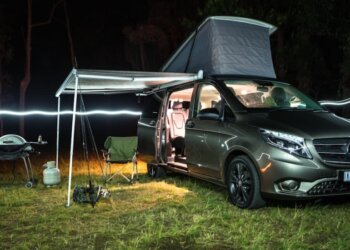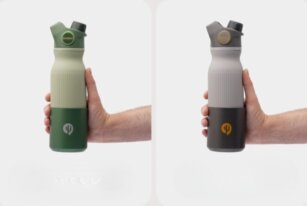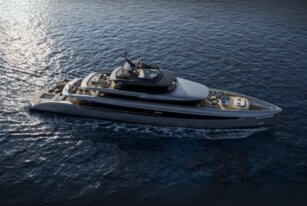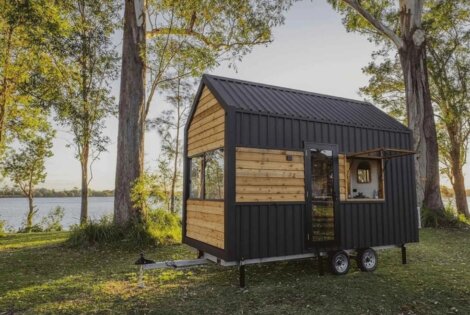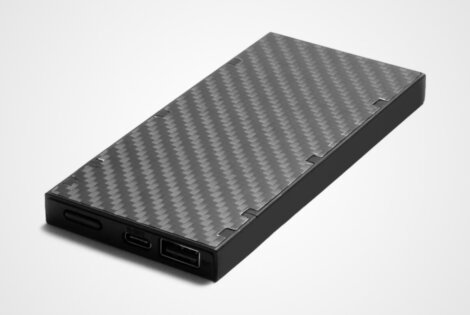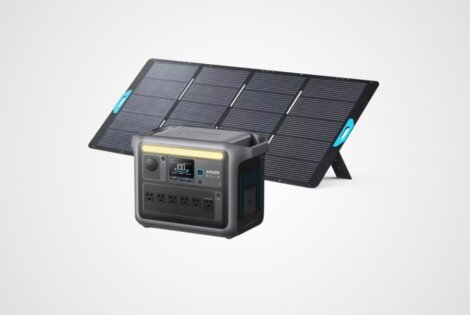BEST CAMPER VANS
1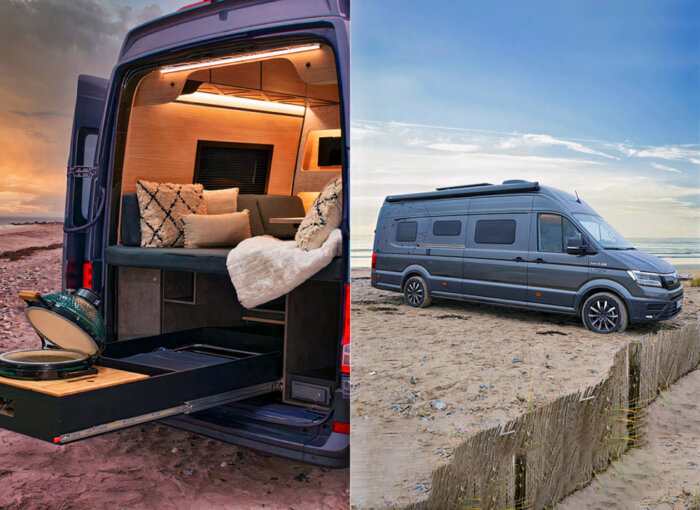
Get ready for a whole lot of vehicle! The Loef packs a 180HP, 2.0L turbodiesel EU6 engine, an 8-speed automatic transmission, and all the modern driving assistance features you could ask for (including backup camera, lake keeping assist, and crosswind assist). With a 24-month mobility guarantee, you get breakdown assistance anywhere in Europe, a replacement vehicle should anything go wrong, and fully paid hotel and return flight costs in case the vehicle experiences total failure.
And wait until you see the luxurious interior with all the features packed in! With front and back seating capable of fitting 10 people, convertible sleeping space for 4 people, a 4-burner gas stove and oven, electric flush toilet, over-sized fridge, and gorgeous matte black sink, it’s an amazing living setup for anyone. But that’s not all! You even get a hidden mini-bar, a Big Green Egg ceramic grill, extra exterior storage space, a fold-out awning, and a specially designed door to keep out the insects in summer.
It’s a camper van built for dreams!
2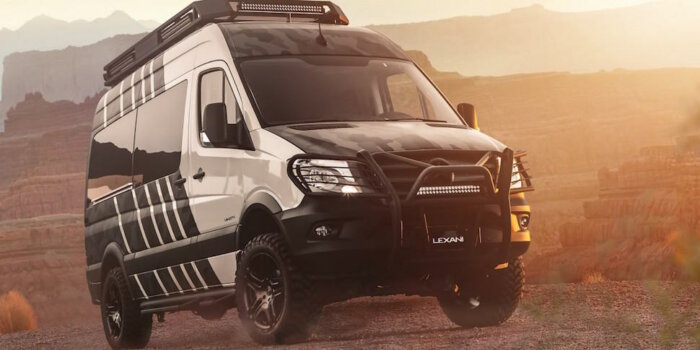
Whether you’re driving through the city or heading for some off-road adventures, the EXTV Kalahari is the vehicle you want. Built for luxury and durability, it brings all the modern comforts you want and wraps them up in a hard-wearing metal body that can handle rough trails, uneven dirt roads, and more. Ski trips, canyon tours, and mountain biking trips are so much better in this vehicle.
The camper van includes a kitchenette, convertible beds and tables, storage cabinets for all your daily essentials, and even more storage for all your outdoor gear (skis, snowboards, bikes, etc.). Oversized, high-traction wheels and extra-bright external LED lights keep you safe and plowing through even the roughest of roads in style!
3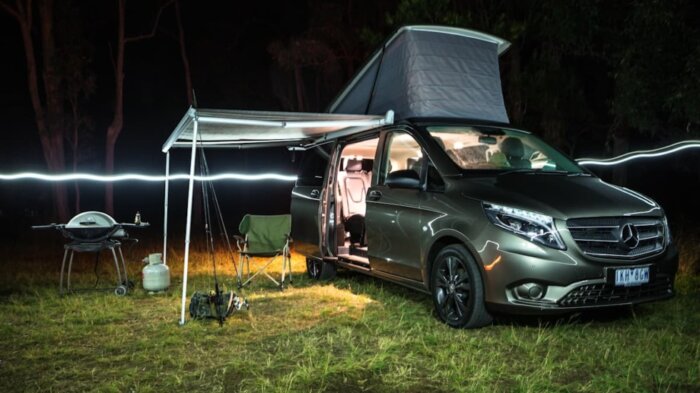
Mercedes Benz is a brand synonymous with elegance, so is it any surprise that their Marco Polo camper van delivers elegance and comfort in truly breathtaking style? Packed with all the power you’d expect from a Mercedes, the Marco Polo takes long-haul driving to a new level, including a fully integrated smart system compatible with both voice control and smartphone connection.
Slide into the back, and you’ve got access to a fully stocked kitchen, complete with folding table, cupboards, shelves, stovetop, oven, and more. Want more space? Just activate the pop-up roof, and you’ve suddenly got 2.35 meters of head room to stretch and move around in comfort. Best of all, the pop-up roof doubles as a roof bed, so you can sleep in style and enjoy some truly spectacular views everywhere you go.
4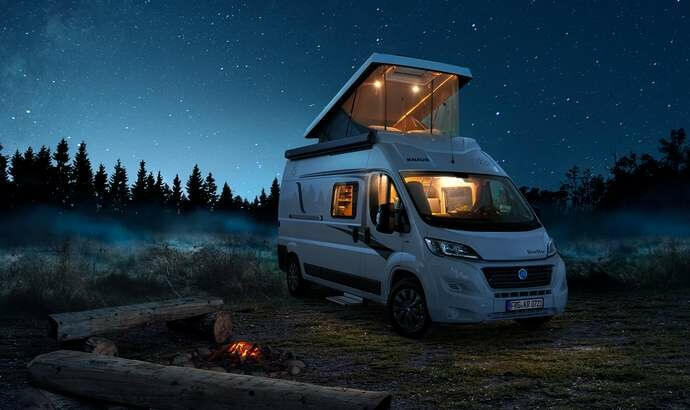
The KNAUS CUV maximizes comfort, sleeping space, and room to move around thanks to the design of its Pop-Up roof, integrated into every one of its CUV models. When the roof is closed, the van can fit in any garage or covered parking space. But when you want more room to breathe, just activate the mechanisms and give your traveling home a whole new second level!
That’s right: the pop-up roof will open up a top floor, complete with an oversized bed (2 x 1.35m), USB chargers and wall sockets, storage compartments, and ambient lighting. Oh yeah, and built-in air conditioning/heating and a truly spectacular view.
It’s sleek, sturdy, and beautifully aerodynamic to save you on fuel economy, but drives well and maximizes safety on the road. Now that’s a camper van you can love.
5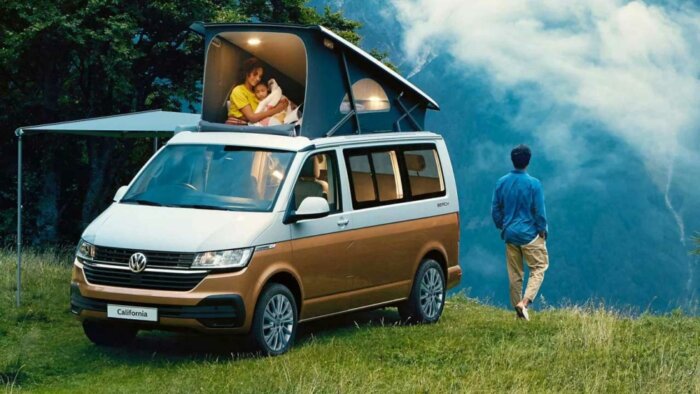
Everyone knows that VW makes some of the best vans—hard-driving, tough-as-nails, and hyper-comfortable. Now VW enters the camper van game with the California 6.1, a lightweight 2WD vehicle perfect for highway adventures and city-hopping, with space enough to sleep 4 (2 adults, 2 children).
The three models—Ocean, Coast, and Beach—offer you multiple options according to your price range and desired features. The higher-end models include parking sensors (rear and front), heat-insulating glass to complement your built-in climate control, and manual controls to elevate the pop-up roof and turn your van’s roof into a sleeping compartment for kids.
For those who want to cook on the go, the compact kitchen includes a small cooler box, stove, and sink, and the van comes with a camping table and chairs you can set up anywhere to have family dinner in style. And when it’s time to kick back and relax, you can enjoy the built-in infotainment system—or, in an emergency, use it to call for help with the press of a button.
6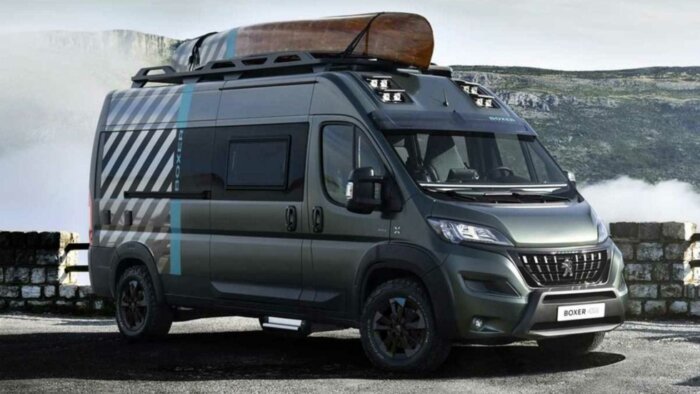
This camper van takes adventure travel to the next level. Not only does it offer full 4WD, but it can be set to “Lock” mode that locks the rear axle when making tough bridge/river crossings. The roof rack is compatible with kayaks, canoes, and small rowboats, but it’s mounted to keep your watercraft safe without interfering with the view through your sun roof. The ladder makes it easy to get up onto the roof safely and load/unload your gear. And for bikers, you’ll love the PEUGEOT eM02 FS Powertube ATV, an electrically assisted mountain bike tough and powerful enough to handle even the most rugged mountain trails.
Climb inside, though, and it feels like you’re entering the lap of luxury itself. The interior has been optimized for your comfort, giving you up to 10m2 of living space, including a bathroom, sleeping area, kitchen, dining room, and, of course plush driving seats. The built-in storage options will more than accommodate all your clothes, gear, and supplies.
But Peugeot takes it a step farther and uses eco-friendly materials, too! The floor is 100% recycled (and recyclable), and the beautiful stone countertop is made from Aragonite, which combines the beauty of porcelain with the durability of natural stone.
7
The Danbury Doubleback opts for an extendable rear cabin as well as a pop-up roof, giving you more space to move around on the “ground floor” of your camping van home. All you have to do is press a button, and the cabin extends outward over the rear bumper to double the original size—it’s right there in the name.
The Doubleback uses a VW body, incorporating technology, techniques, and materials from the aircraft industry to maximize durability and efficiency. It’s surprisingly lightweight despite all the extra room—just 150 extra kilograms—thanks to the aluminum honeycombed pod and support struts. Best of all, the diesel engine is highly fuel-efficient, so you spend less and drive farther.
You get even more space with the removable rear seats, and the bed is fully fold-down-able when it comes time to sleep. It will sleep 4-5 people with ease, and give those same people comfortable seats for a long day of travel. With built-in fresh water supply, wall and USB sockets, an electric slide-out bed, it’s convenience personified.
8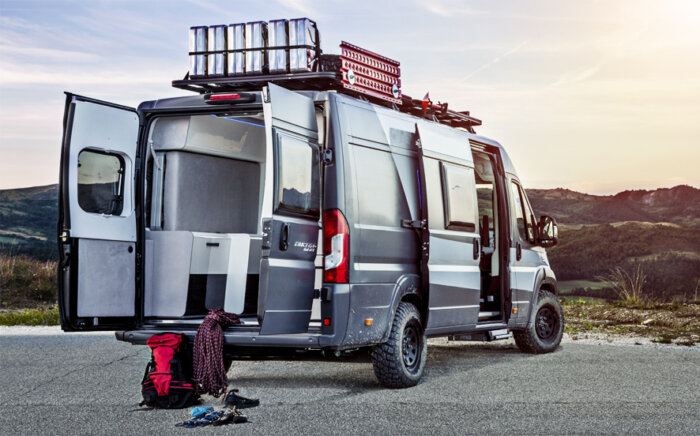
You’d be amazed by how many companies use the Fiat Ducato as the base for their camper van designs—so why not just cut out the middle man and get the best of the best from the manufacturer itself?
The Fiat Ducato is boxy and beautifully spacious, optimizing storage space and increasing load capacity without making the vehicle unwieldy or a road-hog. Steering and turning has been optimized so you’ll always feel like you’re gliding on a cloud even when navigating switchbacks and sharp turns. It’s a van that’s built to be at home on the road, no matter how far you drive.
The interior is also optimized to increase comfort, with plush seats, built-in infotainment and entertainment technology, and fully modular spaces that can be customized uses Fiat’s next-level solutions. It’s best-suited for a couple wanting to adventure travel the world in style, with a beautifully sized bed, simple built-in kitchen, and plenty of rooftop storage for your gear, supplies, kayaks, canoes, bikes, skis, and snowboards.
9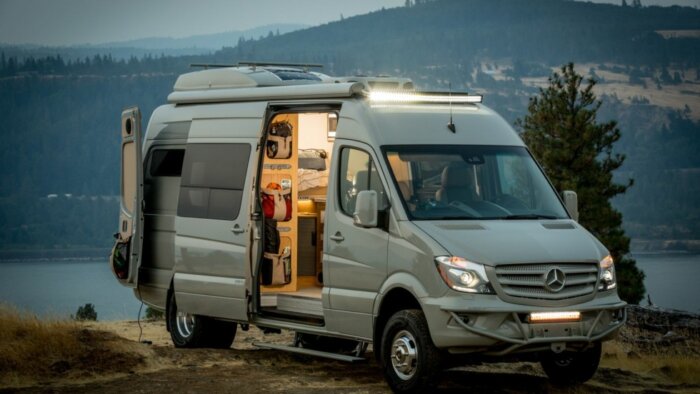
Outside Van’s motto is “live beyond normal”, and once you take a closer look at the vehicle, you’ll agree that it deserves its place on our list as one of the best camper vans for you.
The van itself is tough and rugged, thanks to the Mercedes Benz Sprinter chassis used as the base. But you’ve got full freedom to customize the interior (and some exterior) features exactly the way you want it, or opt for the existing conversion packages.
The Peak design experience will walk you through the myriad options and let you install every tiny detail from the chassis up, while the Fusion experience lets you pick from pre-selected designs that will cost you less and make the process exponentially easier.
At the end of it, you drive away with a van made exactly the way you want it, ideal for whatever type of camper van life you want to live!
10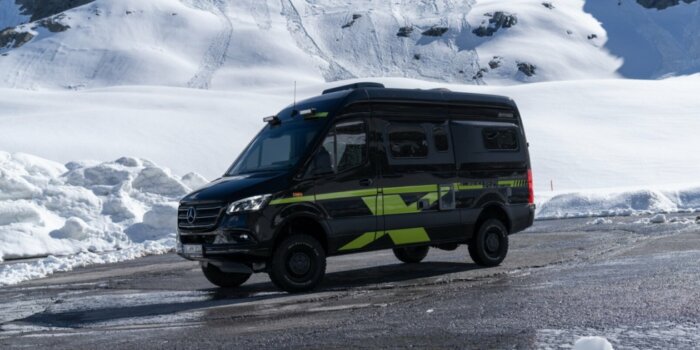
The Hymer Grand Canyon S is a camper van built to let you hit the open road at the drop of a hat, and enjoy your adventure travel in style and comfort.
Built on a Mercedes chassis, the rear wheel drive vehicle has power enough to summit even the steepest mountain roads while being equally at home on city highways and beach trails. If you want to take it off-roading, you can always upgrade to 4WD without sacrificing a single one of your interior luxuries.
And what luxuries! A fully furnished kitchen, complete with extra-tall fridge, a pop-up roof that turns the van’s interior into a two-story place capable of sleeping up to 5, leather-finished furniture, beautifully designed storage space in quite literally every nook and cranny, and a bathroom complete with exterior-mounted shower and built-in medicine cabinet.
11
Westfalia is a brand most people immediately recognize, due to their high-tech, ultra-luxe conversions of VW vans into uber-comfy camper vans. Their latest model, the Columbus 2021, steps everything—comfort, quality, durability, and eco-friendliness—up a notch or two, making it a camper van we’re absolutely glad to recommend.
A few of its coolest features include: a flat-screen TV built in and fully hide-able, super-bright LED lighting, multiple hidden storage spaces (including in ceiling compartments!), a slide-out kitchen, your choice of single or double beds, and even space enough to store two mountain bikes.
Whatever your adventure plans, this camper van is more than up for the task!
12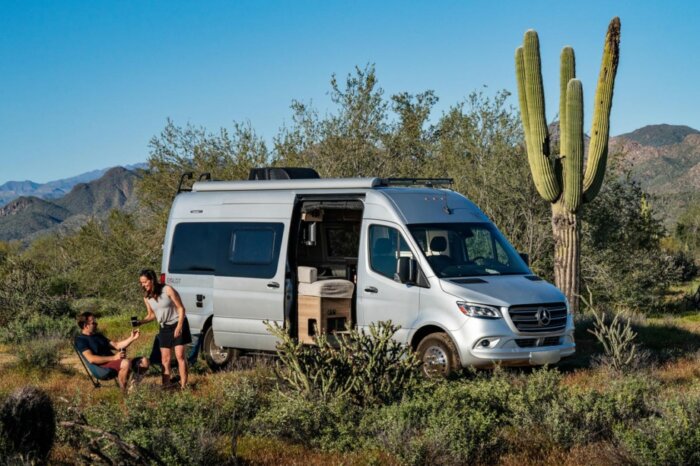
Named after Alexander von Humboldt, the legendary German explorer and cartographer, the Boldt is Winnebago’s latest offering in the camper van market—and one you’ll be glad you heard about.
Powered by a fuel-efficient diesel engine, the camper van is built on a Mercedes chassis with a body that has been customized to make your camping trips as luxurious as possible. You have a choice of two floor plans—one with extra lounging space, the other designed for working on the go—both of which include comfortable twin beds and ergonomic dinette seating.
It’s all-season and all-road ready, with advanced safety systems, ultra-bright LED headlights, and Mercedes’ high-tech onboard infotainment system.
13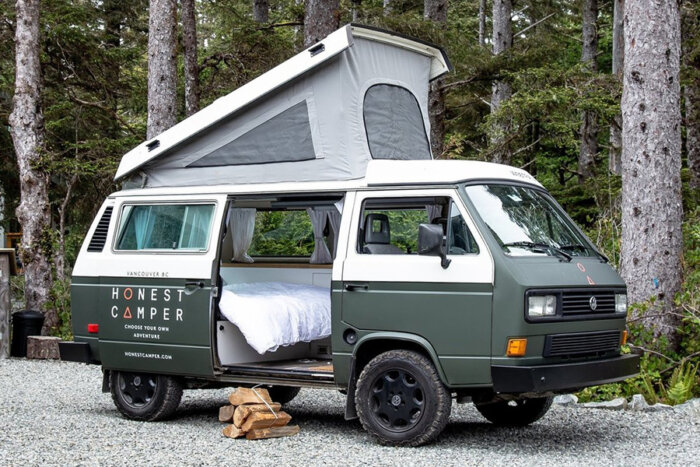
Thinking of trying out the camper van life but don’t know if you’re ready to give up your house or apartment just yet? Give the lifestyle a short test run with Honest Camper!
This Vancouver-based company will rent you out a camper van you can drive all around Canada at a lower cost than a hotel and rental car package. The vehicles are all older-model VW vans, so you know they’re durable and reliable, even on steep or icy roads. But they come packed with all the modern luxuries and amenities you could want—built-in sound system, gas cooktop, sink, fridge/freezer, beds and bedding, even cookware and silverware.
It’s an “all in one” solution that will let you enjoy the camper van life without the high initial investment.
Buying Guide and FAQs
Camper vans are not cheap—often more expensive than RVs—but they provide a compact, comfortable way to see the world in a vehicle you can quite literally park everywhere.
If you’re seriously thinking about taking up the camper life, there are a few things you need to know before you hit the open road.
Factors to Consider:
Size – The size of your camper van will determine where you can park—in a garage, underground parking structures, or even in the parking lot of local supermarkets.
Most camper vans are sized slightly larger than the average van, because they utilize the base chassis (VW, Mercedes, Fiat, Peugeot, etc.) and add on features that make them marginally taller, wider, longer, and, of course heavier.
Size is a factor you need to consider when thinking about where you’ll park in every city, town, or resort you visit. If you get too large a vehicle, you may end up having to pay for RV parking.
Berths – Berths is a fancy way of saying “beds” or “sleeping spaces”. If you’re a single person on the camper van adventure alone, all you really need is one berth and you’re good to go. But add more travelers—spouse, kids, friends, and pets—and things can get a bit more complicated.
When traveling with a spouse, for example, you’ll likely need at least a double bed. Camper vans are too narrow for queen-sized beds, so you will have to be okay with the idea of sleeping pressed up close to your partner. If you need room to move around, you might have to opt for a size up and go full RV.
Kids and pets will typically be able to sleep just about anywhere—single beds, even fold-down couches and cots. But if you’re traveling with more adults (buddy road trip!), make sure the provided beds are sized for grown-ups.
Space – Space is another critical factor to consider. You want to make sure that everyone traveling is comfortable—not only buckled into their seats, but also when lounging or playing around at the end of the day. If the camper van’s interior is too cramped or you are too many people, you might end up stepping all over each other—and that’s just no fun.
Most camper vans are sized for 4 people (some up to 5), but include seating for as many as 8-10. But that’s vehicle seating, not couches, table space, or beds. If you’re going to be hauling around a lot of passengers, you may want to bring tents for people to set up camp next to your van, as well as camping chairs and tables for everyone to sit around once the day of driving is done. You can do all the cooking and washing up in the van, but the great outdoors will give you more room for additional passengers.
Facilities – Camper vans are popular because they provide a more compact travel alternative to RVs, providing not just beds, but also the critical facilities—both kitchen and bathroom.
Camper vans will always include a sink, stove, and fridge, but ovens are surprisingly rare. The amount of fridge and freezer space will vary from van to van—typically between 50 and 95L combined. All vans include a fresh water tank to provide clean water for washing dishes, but you may pay extra to include a water heater if you want hot running water.
As for bathroom facilities, you can expect a toilet and some kind of bathroom storage, but sinks and showers aren’t guaranteed. Some camper vans eliminate a bathroom sink completely (you can always wash your hands in the kitchen sink) to save space. And if the van has some form of shower facilities, they’ll usually be connected with a hose that can run through the bathroom window so you can shower outside. There’s just not enough space inside the van for a tub or shower stall.
Storage – There are two types of storage space to consider: interior and exterior.
Interior storage is typically occupied by your clothes, foodstuffs, electronics, and other items essential for your everyday travel. Every camper van will have its own unique storage solutions—beneath seats, tucked into the roof, beneath the fold-down bed, even on the pop-up roof—so you will definitely have to get creative with how you organize everything.
External storage may include roof racks or a hitch that lets you mount kayaks, bikes, snowboards, skis, and other outdoor gear.
Vehicle Longevity and Handling – This is, of course, always a critical factor to consider. After all, a camper van that doesn’t go anywhere because of engine, transmission, or other mechanical problems is of no use to you. The “van” part is just as important as the “camper” part!
Most camper vans are made using the chassis of respected vehicle manufacturers like VW, Mercedes, Fiat, or Peugeot. Obviously this is done because these vehicle chassis are sturdy and reliable.
However, it’s always worth doing some research into breakdown problems common to the camper van you’re considering buying. You’ll find that each brand is prone to its own issues that could be avoided/prevented with regular maintenance.
(Outbound Living has a great article on camper van maintenance here…)
And, of course, you want to consider how well the vehicle handles. Camper vans are going to be more top-heavy than regular vans, often with a boxy frame that may tip when you make sharp turns. They may also be less-than-ideal for off-roading (unless you buy a vehicle specifically for that purpose, like the Peugeot Boxer 4×4), sandy beach trails, or rough dirt roads.
Camper Van FAQs
Can you legally live in a camper van?
There are no federal laws that stop you from sleeping in your vehicle; the laws just govern where you park. They typically pertain to people who sleep within city limits, with their vehicles parked in busy areas or on the side of highways and heavily traveled roads. 24 states have laws against it:
- Colorado
- Delaware
- Florida
- Georgia
- Hawaii
- Indiana
- Iowa
- Kentucky
- Louisiana
- Maine
- Maryland
- Massachusetts
- New Hampshire
- North Carolina
- North Dakota
- Pennsylvania
- Rhode Island
- South Carolina
- South Dakota
- Tennessee
- Vermont
- Virginia
- West Virginia
- Wisconsin
As long as you are parked in the right place (RV parking, underground garage, or parking lots where overnight parking is permitted), you should have no trouble with the law.
Do I need to register my van as a camper van?
You don’t need to, but you want to. Re-titling your camper van as an “RV” instead of a “van” ensures the insurance company provides the proper coverage—not only for your vehicle, but also for all the valuable items stored inside. If you don’t register your van as a camper van, the insurance company may deny your claim in case of an accident because a) their plan doesn’t cover the total cost of the vehicle, and b) you weren’t using the van for its registered purpose (hauling cargo).
Can I park a camper van anywhere?
During the day, your camper van can be parked anywhere regular vehicles are parked (provided it fits within the guide lines). Overnight, however, you cannot park in public places unless “Overnight parking permitted” is specifically stated.
Public lands operated by the Bureau of Land Management are typically free to park for up to 14 days at a time. Most Walmarts will allow RVs (and camper vans, of course) to park overnight, though some may ask you to leave. Smaller side streets with no parking restrictions are usually a good option for overnight parking. There are also apps and online communities—like Boondockers Welcome, Harvest Hosts, and HipCamp—that will connect you to private property owners willing to let you park (for free or a nominal fee).
Where can I shower while traveling in a camper van?
Campgrounds, national parks, recreation centers, hot springs, and truck stops all provide free or cheap places to shower. Or, consider buying your own portable shower—like the Yakima Roadshower—to take your shower with you everywhere you go.
Can I live off the grid in my camper van?
Camper vans can be upgraded to be self-sufficient, to an extent. Power is going to be your biggest problem—your vehicle roof may be taken up by storage racks, stopping you from installing solar panels. You can get power from the vehicle itself, though that will use up a lot of gas. Hauling around a portable generator may be less-than space-efficient, but it’s a good option if you need.
Sourcing water can also be tough, and there’s no way to provide your own food. The best you can opt for its disconnecting yourself from the grid, but occasionally reconnecting to stock up on supplies, fresh water, fuel, and power.


